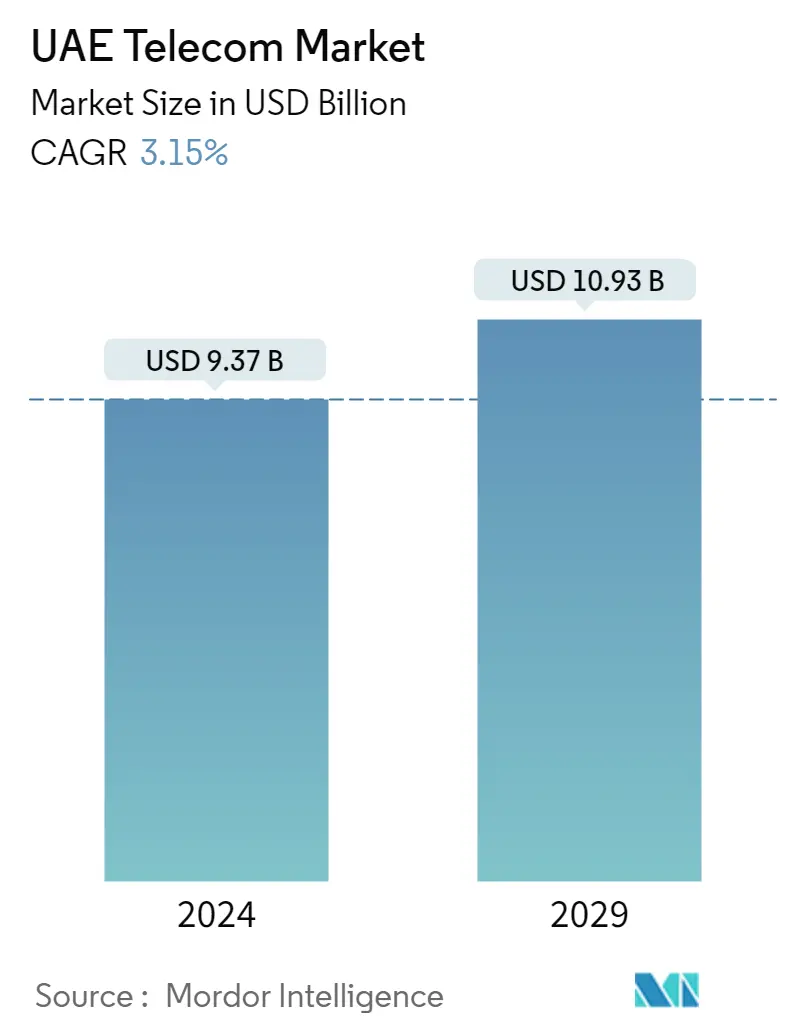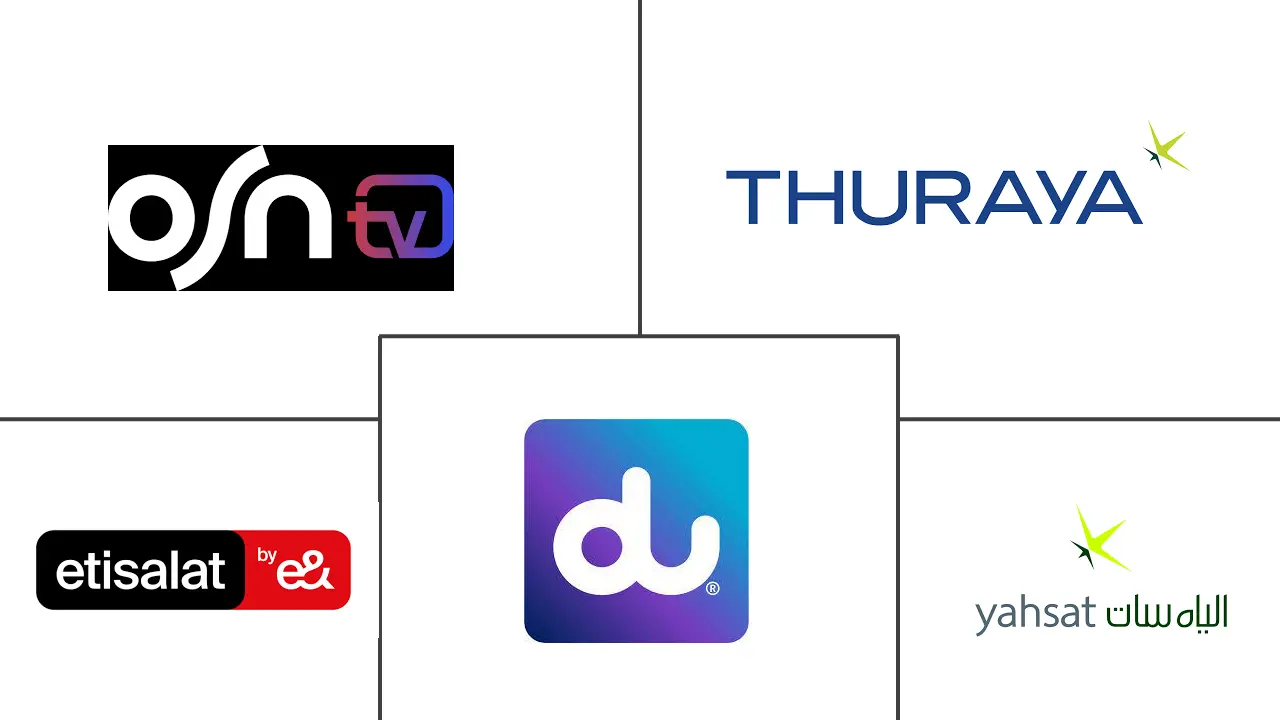Market Size of UAE Telecom Industry

| Study Period | 2019 - 2029 |
| Base Year For Estimation | 2023 |
| Market Size (2024) | USD 9.37 Billion |
| Market Size (2029) | USD 10.93 Billion |
| CAGR (2024 - 2029) | 3.15 % |
| Market Concentration | High |
Major Players
*Disclaimer: Major Players sorted in no particular order |
UAE Telecom Market Analysis
The UAE Telecom Market size is estimated at USD 9.37 billion in 2024, and is expected to reach USD 10.93 billion by 2029, growing at a CAGR of 3.15% during the forecast period (2024-2029).
The UAE telecom market has undergone significant transformation over the past few years owing to various initiatives taken by the government to boost the country's internet infrastructure and broadband connection, data consumption from businesses and individuals, 5G deployments, and various innovations by major telecom market vendors operating in the United Arab Emirates.
- As per the World Bank, 100% of the country's population has access to the Internet. With a growing percentage of the population using smartphones, the enhanced service quality offered by operators, and technology and infrastructure upgrades, internet users are expected to increase further.
- The increasing penetration of 5G and the advent of 6G are expected to drive the market's growth. For instance, the median download speed on 5G networks is among the fastest in the world, and the fixed broadband speed is among the highest. This is the outcome of recent infrastructure expenditures prioritizing fiber over updated copper networks and 5G.
- In 2023, the United Arab Emirates implemented the 5G technology. Its execution in the country was expected to bring enhanced mobile broadband services and improved connectivity for the Internet of Things (IoT) and support new and innovative applications and services.
- The growing spending on communication is one of the major factors contributing to the market's growth. The market has primarily benefitted from the increasing smartphone penetration and high demand for telecom services from individuals and businesses over the past few years. The country has been accelerating its digital strategy adoption in various industries and prioritizing integrating all populations through high-quality internet services, which would create an opportunity for the mobile internet service providers in the country to expand their mobile connectivity services, including 2G, 3G,4G, and 5G.
- However, as the country is highly dependent on external sources to balance the skill deficit, it may face challenges in the coming years as dependency on foreign talent may lead to vulnerability if visa regulations change, restricting the availability of skilled labor. A predominantly foreign workforce may impact the representation of Emirati nationals within the sector, affecting the nation's participation in the telecom industry. In response to these challenges, the UAE telecom industry needs to strike a balance between leveraging the advantages of foreign talent and investing in the development of local expertise.
- Post-COVID-19, the adaptation or changes in the communication behaviors of consumers are predicted to influence the future dynamics of the UAE telecom industry. Customers choosing digital services such as online ordering, mobile payments, and strong collaboration tools will be the new standard for telecom service providers post-crisis. Telcos should continue to invest in their network infrastructure to meet these future needs.
UAE Telecom Industry Segmentation
Telecom or telecommunication refers to all states of data, voice, and video transmission and describes the electronic exchange of information over great distances. It includes various information-transmitting technologies and communications infrastructures, including landlines, cell phones, mobile phones, satellites, fiber optics, television, microwave communications, radio, the Internet, and telegraphs.
The UAE telecom industry is segmented by telecom services (voice services [wired, wireless], data and messaging services, OTT and pay-TV services) and telecom connectivity (fixed network, mobile network). The report offers market forecasts and size in value (USD) for all the above segments.
| Telecom Services | ||||
| ||||
| Data and Messaging Services | ||||
| OTT and PayTV Services |
| By Telecom Connectivity | |
| Network | |
| Mobile Network |
UAE Telecom Market Size Summary
The UAE telecom industry is experiencing a dynamic transformation driven by government initiatives to enhance internet infrastructure and the rapid deployment of 5G technology. This evolution is supported by significant investments in fiber-optic networks, which have replaced older copper systems, resulting in some of the fastest internet speeds globally. The market is characterized by a high penetration of smartphones and a growing demand for advanced telecom services, including IoT and smart home applications. Major players like Etisalat and Du are at the forefront, expanding their networks and introducing innovative services to meet the increasing demand for high-speed connectivity. The adoption of digital services and cloud solutions is further propelling the market, as businesses and consumers alike seek reliable and efficient communication solutions.
The market's growth is also influenced by the rising use of data and messaging services, driven by the increasing number of internet and social media users in the UAE. Telecom vendors are offering flexible and cost-effective data packages to attract a broader customer base, while the introduction of 5G technology has significantly boosted mobile network capabilities. Despite the challenges posed by a reliance on foreign talent, the industry continues to thrive, with strategic partnerships and technological advancements paving the way for future growth. The UAE's commitment to integrating advanced technologies and enhancing digital infrastructure positions it as a leading player in the regional telecom sector, with substantial opportunities for expansion and innovation.
UAE Telecom Market Size - Table of Contents
-
1. MARKET INSIGHTS
-
1.1 Market Overview
-
1.2 Industry Attractiveness - Porter's Five Forces Analysis
-
1.2.1 Bargaining Power of Suppliers
-
1.2.2 Bargaining Power of Buyers
-
1.2.3 Threat of New Entrants
-
1.2.4 Threat of Substitutes
-
1.2.5 Intensity of Competitive Rivalry
-
-
1.3 An Assessment of the Impact of Recent Geopolitical Developments on the UAE Telecom Market
-
1.4 Analysis of Regulatory Reforms
-
1.5 Pestle Analysis Telecom Sector in United Arab Emirates
-
-
2. MARKET SEGMENTATION
-
2.1 By Overall Telecom Revenue
-
2.2 Telecom Services
-
2.2.1 Voice Services
-
2.2.1.1 Wired
-
2.2.1.2 Wireless
-
-
2.2.2 Data and Messaging Services
-
2.2.3 OTT and PayTV Services
-
-
2.3 By Telecom Connectivity
-
2.3.1 Network
-
2.3.2 Mobile Network
-
-
UAE Telecom Market Size FAQs
How big is the UAE Telecom Market?
The UAE Telecom Market size is expected to reach USD 9.37 billion in 2024 and grow at a CAGR of 3.15% to reach USD 10.93 billion by 2029.
What is the current UAE Telecom Market size?
In 2024, the UAE Telecom Market size is expected to reach USD 9.37 billion.

